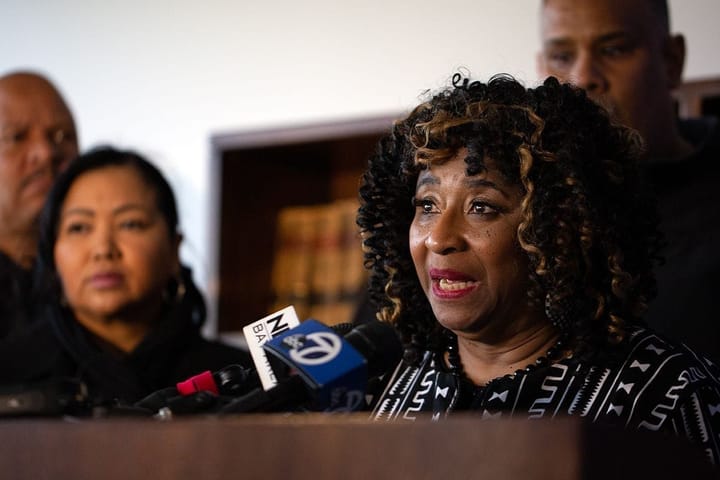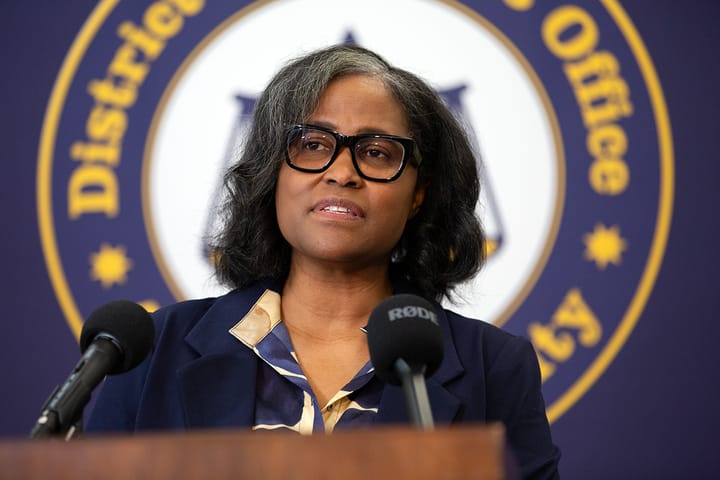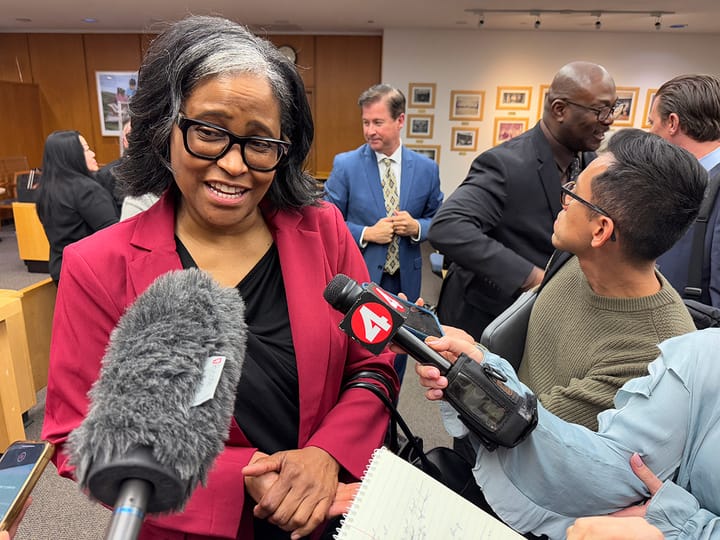Triple murder case begins for alleged Berkeley gang member
Authorities say Joe Carroll Jr. was a Waterfront gang member who killed three men and tried to kill three others between 2009 and 2011.

A triple murder case began Monday for Joe Carroll Jr., an alleged Berkeley gang member who authorities say unleashed violence to settle his scores.
The case centers around four Oakland shootings from 2009 to 2011 that took the lives of three men and wounded three others.
Carroll, now 37, was in his early 20s at the time of the shootings.
His defense attorneys — Todd Bequette and William Welch — say the key witnesses in the case are "convicts, murderers and fraudsters" who have "an incentive to lie to benefit themselves."
The case, before Judge Jason Chin, is expected to last for months.
Due to security concerns, the courtroom vestibule has been outfitted with a metal detector. All attendees must show a photo ID to enter. No electronic devices are allowed without a court order.
The day began with an announcement from the judge that two jurors had already become unavailable. He appointed two alternates to the jury, leaving four extras still on deck.
3 dead, 3 wounded in 4 shootings
In her opening statement Monday morning, prosecutor Natasha Jontulovich provided an overview to jurors about what is certain to be a difficult case to follow.
She said Joe Carroll had shot Nguyen Ngo and his brother, Bao, on 45th Street in North Oakland in an "unprovoked" ambush in April 2009.
Court papers indicated that sparring on MySpace may have sparked the violence, adding fuel to an ongoing feud between gang members in Berkeley and Oakland.
Bao survived the shooting but Nguyen did not.
The next shooting took place about a year later, in May 2010, outside the Acorn apartment complex in West Oakland. Two men were shot but survived.
At the time of the shooting, one of those men was dating a woman who had a child with Carroll, creating what the prosecution called a contentious situation.
Police found 17 shell casings at the scene, another "ambush," said Jontulovich. OPD determined that all the bullets had been fired from a single gun.
About five weeks later, in June 2010, Nehemiah Lewis was fatally wounded in a shooting on Athens Avenue in Oakland. All nine casings at the scene came back to a single gun.
The last named victim, Andrew Henderson Jr., was killed in an Oakland shooting in April 2011.
Read more about gangs in Berkeley.
The cases largely went cold until 2016 when OPD homicide detective Jose Barocio went back over them to see what may have been missed.
The Alameda County DA's office filed charges against Carroll the next year. He's been in custody ever since.
"There are many witnesses in this case," Jontulovich told the jury Monday. "They don't want to be here. That will be abundantly clear."
She said some of the witnesses are serving time in state prison. Others were arrested so they would have to take the stand.
"I don't know what they're going to say," Jontulovich said. "We will be taking that journey together."
Alleged Waterfront gang members from Berkeley to testify
Some of the key witnesses will be Joe Carroll's former friends and associates, she said.
They include alleged Waterfront gang members Emando Roos and Gregg Fite, "who admitted his involvement" — as well as Carroll's alleged involvement — in the North Oakland shooting that killed Nguyen Ngo.
Fite "did strike a deal" with the DA's office in exchange for testimony about the gang feud as well as details about his conversations with Carroll.
"He is gonna tell you about the reasons behind certain shootings," Jontulovich said. "He knows the history."
Another key witness is expected to be Brandon Wallace, a Waterfront gang associate who sent a letter to the U.S. attorney's office in 2016 saying "he would be willing to provide information" about unsolved shootings and murders in exchange for a deal.
As part of their investigation, police put Wallace in a Berkeley Jail cell with Joe Carroll, who allegedly made admissions to him about some of the crimes.
Jontulovich warned the jury that the path forward would be convoluted: Evidence from all four shootings would be presented "completely out of order," she said.
"I ask you to bear with me through this process," she said.
Defense: "They were desperate to name someone"
Defense attorney William Welch began his opening statement by greeting the judge, the prosecutor and each member of the court staff before standing behind his client, placing both hands on Carroll's shoulders and acknowledging his client's presence in court.
"It is my honor to be able to give this opening statement," he told the jury.
Welch pointed out the many years that had passed since the shootings and said initial investigators had not done "routine things" that could have led to leads.
By 2016, Welch said, when "a new set of eyes takes a look at it," police had "lost their objectivity with respect to Mr. Joseph Carroll."
Welch said authorities had cherry-picked evidence to save face given all the open cases.
"They were desperate to name someone," he told the jury. Indicating his client, he added: "They wanted that man right there."
Welch urged jurors to be suspicious of the upcoming testimony, particularly from any witness who had something to gain from being on the stand.
He said Gregg Fite, for example, had negotiated "a guaranteed release" and an immunity deal that had "handcuffed this very office" — the DA's office — "in terms of how it could prosecute him."
He said Fite had become a "paid government informant" and that other eyewitness testimony would contradict his version of events.
For example, he said, Fite claimed Joe Carroll was in the backseat during the North Oakland drive-by shooting in 2009.
But a girl from the neighborhood who talked to police had insisted no one had been in the back, Welch said. She had described with certainty having an unimpeded view through the back windows of the shooter's car.
She and a friend who had been walking in the area when gunfire broke out both described the shooter in the front seat.

Welch also cast suspicion on witness Brandon Wallace, noting that he had been sentenced to 118 years in prison in a Berkeley murder case.
After his appeals on that case failed, Welch said Wallace contacted OPD and claimed Joe Carroll had told him things that would help solve their cold cases.
Welch said Wallace had been a friend of Coleon Carroll, Joe's younger brother, but was never close to Joe.
And he said other witnesses would contradict Wallace's story about the Henderson killing in 2011.
"It's clearly fabricated," Welch said. "The hope that he won't have to spend the rest of his life in prison, that's what's motivating him."
After hearing all the evidence, he said the defense team hoped jurors would come back with not-guilty verdicts on all charges.
"We ask that you return those verdicts and do justice — because integrity matters," Welch said.
Fatal shooting on 45th Street
Five witnesses took the stand Monday to answer questions about the North Oakland shooting on April 23, 2009: two minor law enforcement witnesses; the two women who had, as teenagers, happened past the fatal shooting on 45th Street; and a woman who had been parked on Market Street near 45th waiting for her cousin to leave the barbershop.
The former teenagers who had been walking on 45th Street testified that they didn't remember much about what happened that day.
Their testimony relied largely on transcripts from past statements, which attorneys read into the record in hopes of refreshing their memories.
"I don't remember saying this stuff," one of the women said, adding: "I was forced to be here today. You guys hunted me down."
Both women said they had been honest with police when they spoke to them 15 years ago.
At the time, one of the girls had described what she believed was a tan Buick that pulled up just before the shooting. She had seen a driver and front passenger.
She told police the driver had pulled out a 3-foot gun with two handles and opened fire.
The other girl also told police that the driver had pulled out a rifle and that she'd heard four shots.
"Everybody was screaming, looking out the window saying, don't move them, don't move them," she had said, of the victims.
Through the commotion, she saw Nguyen Ngo on the ground with his hands over his chest, shouting "Help me!"
Ngo's friends and his brother, who also had been wounded, ran over to him, loaded him into a black Cadillac and rushed him to Highland Hospital.
She said she'd only seen one person in the car but never saw his face.
She also recalled how the group including the Ngo brothers had just stood there when the driver first stopped beside them.
"They didn't start running or anything, so we thought they were gonna start talking," she had told police 15 years ago. After the shooting, the driver casually pulled away and drove off.
On the stand Monday, she said she didn't recall most of those details — but had no reason to doubt what she'd told police.
Witness: "I didn't want to be here"
The final witness of the day was Berkeley native Lalane Coaxum. She had been parked on Market Street near 45th when she heard gunshots.
She said her first two thoughts were "get down" and "get away," but she found herself blocked into her parking spot by passing traffic.
"Don't look," she had also told herself, hoping not to see anything significant.
"I didn't want to be here," she explained. "I didn't want to be a witness."
Coaxum said she had later been motivated to talk to police primarily because her sister had been killed in 2007 in an unsolved Oakland shooting, and she felt it was her duty to provide tips if she expected others to do the same.
"I'm going through a lot of emotions due to the death of my sister," she testified. "Sometimes you want to help the police and sometimes you don't."
As it turned out, Coaxum's sister had been a passenger in a car driven by none other than Joe Carroll when she was killed in 2007.
Carroll was her sister's boyfriend at the time, but Coaxum never met him.
Two years later, on Market Street, Coaxum described how a gold Mercedes had stopped beside her stuck in traffic shortly after she heard gunfire.
She told police that Joe Carroll had been crouching down in the backseat and that Coleon Carroll, Joe's brother, was behind the wheel.
Less than a minute later, a dark-colored Charger had also passed her, pulling in front of her at a stop sign. The driver was an old Berkeley schoolmate, whom she called "George Fife."
(According to court papers, that individual is actually named Gregg Fite.)
On Monday, Coaxum said her memory of the shooting had been "tainted" years earlier by a transcript that had been going around Berkeley of Fite's prior testimony about the case.
Over the years, she said, she had mixed up what she had seen with what she had read.
On the stand Monday, she denied seeing either Carroll brother in the gold car.
In response to questions from prosecutor Jontulovich, Coaxum said she did think a man may have been in the backseat but had no clear memory of him.
"It could have been, but I'm still unsure," Coaxum said. "I cannot say anything of those details."
"These aren't your memories, are they?" defense attorney Welch later asked her.
"Some things are and some things I can't say," she told him. "It's been very emotional and traumatic."
Coaxum did say she was certain of one thing: that Joe Carroll had not been driving the gold Mercedes.
She also testified that it was "hard to be on the prosecution side" in court because Joe Carroll had reportedly killed one of his victims, Andrew Henderson Jr., because Henderson had been the one to kill her sister in 2007.
"I'm very scared to be a witness due to retaliation," she added. "At the same time, I'm not really sure what this case is about."
Several victim family members and about a dozen of Carroll's supporters attended Monday's proceedings.
Testimony in the case resumes Tuesday morning.





